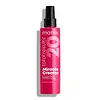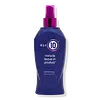What's inside
What's inside
 Key Ingredients
Key Ingredients

No key ingredients
 Benefits
Benefits

 Concerns
Concerns

 Ingredients Side-by-side
Ingredients Side-by-side

Water
Skin ConditioningCocos Nucifera Oil
MaskingAmodimethicone
Polyquaternium-37
Phenoxyethanol
PreservativePropylene Glycol Dicaprylate/Dicaprate
EmollientParfum
MaskingAcetamide Mea
HumectantLactamide Mea
HumectantDimethicone PEG-7 Phosphate
CleansingPPG-1 Trideceth-6
Skin ConditioningTrideceth-6
EmulsifyingBehentrimonium Chloride
PreservativeGlycine Soja Oil
EmollientPrunus Amygdalus Dulcis Oil
Skin ConditioningXylose
HumectantLactic Acid
BufferingEthylhexylglycerin
Skin ConditioningCetrimonium Chloride
AntimicrobialHydrolyzed Vegetable Protein Pg-Propyl Silanetriol
Skin ConditioningLinalool
PerfumingCoumarin
PerfumingSodium Hydroxide
BufferingWater, Cocos Nucifera Oil, Amodimethicone, Polyquaternium-37, Phenoxyethanol, Propylene Glycol Dicaprylate/Dicaprate, Parfum, Acetamide Mea, Lactamide Mea, Dimethicone PEG-7 Phosphate, PPG-1 Trideceth-6, Trideceth-6, Behentrimonium Chloride, Glycine Soja Oil, Prunus Amygdalus Dulcis Oil, Xylose, Lactic Acid, Ethylhexylglycerin, Cetrimonium Chloride, Hydrolyzed Vegetable Protein Pg-Propyl Silanetriol, Linalool, Coumarin, Sodium Hydroxide
Water
Skin ConditioningPropylene Glycol
HumectantCetearyl Alcohol
EmollientCyclopentasiloxane
EmollientBehentrimonium Chloride
PreservativePanthenol
Skin ConditioningSilk Amino Acids
HumectantAloe Barbadensis Leaf Juice
Skin ConditioningCamellia Sinensis Leaf Extract
AntimicrobialHelianthus Annuus Seed Extract
Skin ConditioningQuaternium-80
Butylene Glycol
HumectantPhenoxyethanol
PreservativeMethylparaben
PreservativePropylparaben
PreservativeEthylparaben
PreservativeParfum
MaskingCitronellol
PerfumingHexyl Cinnamal
PerfumingLimonene
PerfumingLinalool
PerfumingWater, Propylene Glycol, Cetearyl Alcohol, Cyclopentasiloxane, Behentrimonium Chloride, Panthenol, Silk Amino Acids, Aloe Barbadensis Leaf Juice, Camellia Sinensis Leaf Extract, Helianthus Annuus Seed Extract, Quaternium-80, Butylene Glycol, Phenoxyethanol, Methylparaben, Propylparaben, Ethylparaben, Parfum, Citronellol, Hexyl Cinnamal, Limonene, Linalool
 Reviews
Reviews

Ingredients Explained
These ingredients are found in both products.
Ingredients higher up in an ingredient list are typically present in a larger amount.
This ingredient is a preservative and often used for it's anti-static properties. You'll most likely see this ingredient in hair conditioners.
It does not cause irritation or sensitization in leave-on products at 1-5%.
Linalool is a fragrance and helps add scent to products. It's derived from common plants such as cinnamon, mint, citrus, and lavender.
Like Limonene, this ingredient oxidizes when exposed to air. Oxidized linalool can cause allergies and skin sensitivity.
This ingredient has a scent that is floral, spicy tropical, and citrus-like.
Learn more about LinaloolParfum is a catch-all term for an ingredient or more that is used to give a scent to products.
Also called "fragrance", this ingredient can be a blend of hundreds of chemicals or plant oils. This means every product with "fragrance" or "parfum" in the ingredients list is a different mixture.
For instance, Habanolide is a proprietary trade name for a specific aroma chemical. When used as a fragrance ingredient in cosmetics, most aroma chemicals fall under the broad labeling category of “FRAGRANCE” or “PARFUM” according to EU and US regulations.
The term 'parfum' or 'fragrance' is not regulated in many countries. In many cases, it is up to the brand to define this term.
For instance, many brands choose to label themselves as "fragrance-free" because they are not using synthetic fragrances. However, their products may still contain ingredients such as essential oils that are considered a fragrance by INCI standards.
One example is Calendula flower extract. Calendula is an essential oil that still imparts a scent or 'fragrance'.
Depending on the blend, the ingredients in the mixture can cause allergies and sensitivities on the skin. Some ingredients that are known EU allergens include linalool and citronellol.
Parfum can also be used to mask or cover an unpleasant scent.
The bottom line is: not all fragrances/parfum/ingredients are created equally. If you are worried about fragrances, we recommend taking a closer look at an ingredient. And of course, we always recommend speaking with a professional.
Learn more about ParfumPhenoxyethanol is a preservative that has germicide, antimicrobial, and aromatic properties. Studies show that phenoxyethanol can prevent microbial growth. By itself, it has a scent that is similar to that of a rose.
It's often used in formulations along with Caprylyl Glycol to preserve the shelf life of products.
Water. It's the most common cosmetic ingredient of all. You'll usually see it at the top of ingredient lists, meaning that it makes up the largest part of the product.
So why is it so popular? Water most often acts as a solvent - this means that it helps dissolve other ingredients into the formulation.
You'll also recognize water as that liquid we all need to stay alive. If you see this, drink a glass of water. Stay hydrated!
Learn more about Water